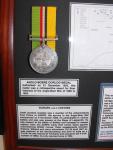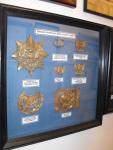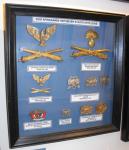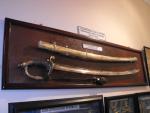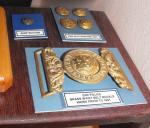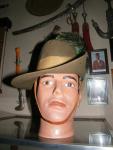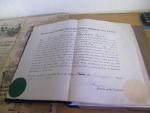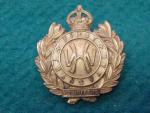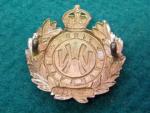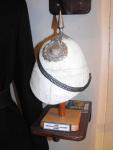
sabrigade
For Deletion-
Posts
1,707 -
Joined
-
Last visited
-
Days Won
33
Content Type
Profiles
Forums
Blogs
Gallery
Events
Store
Everything posted by sabrigade
-
The Zuid Afrikaansche Republike Politie - ZARPS
sabrigade replied to sabrigade's topic in Police Forces of the World
-
The Zuid Afrikaansche Republike Politie - ZARPS
sabrigade replied to sabrigade's topic in Police Forces of the World
http://gmic.co.uk/uploads/monthly_10_2012/post-3034-0-46442400-1350923340.jpghttp://gmic.co.uk/uploads/monthly_10_2012/post-3034-0-80229000-1350923402.jpg -
The Zuid Afrikaansche Republike Politie - ZARPS
sabrigade replied to sabrigade's topic in Police Forces of the World
ZUID AFRIKAANSCHE REPUBLIEK POLITIE (ZARPS) This force was the mounted and foot police of the Transvaal. From 1881 to 1896 the ZARPS were part of the Artillery and then began a separate existence as an independent entity. In 1899, the force consisted of 10 officers, 100 NCO’s and 1400 men. The majority of the force was foot police but they all took to the field and entered the Anglo-Boer War as mounted forces. The ZARPS fought well and earned a reputation for their tenacity, skill and courage. In peacetime they carried swords, carbines and revolvers. During the Anglo-Boer war the ZARPS carried the Mauser rifle. Mr L.S. Amery stated that “the police were first-class fighters, combining the skill of the Boer with the courage and self-sacrifice of the disciplined soldier”. The “fighting” ZARPS accompanied the Boer forces from the Transvaal that invaded Natal. They participated in many major and minor engagements but gained enduring fame at the Battle of Dalmanutha or Diamond Hill where they were destroyed as a unit. Individual members as well as the last contingent of the ZARPs continued to fight in the Eastern Transvaal during the guerrilla and final stage of the Anglo-Boer War. -
The Zuid Afrikaansche Republike Politie - ZARPS
sabrigade replied to sabrigade's topic in Police Forces of the World
STAATS ARTILLERIE VAN DE O.V.S. 1857 TO 1900 During the period 1857 to 1864, 12 field pieces were imported by the O.F.S. government. Two of these field guns saw service in the 1858 Basotho War. The force was commanded in 1864 by Captain Goodman, a former member of the Royal Artillery. He had been made Commandant and had a staff of seven members. During the Basotho Wars from 1865 to 1869, the strength of the force was increased and five guns were in the field. In 1880, Major Albrecht of the German Army took over with one officer, 55 other ranks and 300 reservists. Albrecht had 12 modern Armstrong guns; four horsed and was responsible for policing the borders of the state with 20 men. In 1896 the Artillery was relieved of this duty and reorganised. The new equipment included 14 7.5-cm Krupp guns. With these guns and five officers and 159 other ranks the force entered the Anglo-Boer war. At the outbreak of the war, the other ranks were increased to 400 men. The Staats Artillerie of the O.V.S. did good service until the beginning of the guerrilla war phase of the Anglo-Boer War. Major Albrecht fought in the Anglo-Boer War and was captured at Paardeberg. -
The Zuid Afrikaansche Republike Politie - ZARPS
sabrigade replied to sabrigade's topic in Police Forces of the World
STAATS ARTILLERIE VAN DE ZAR 1874 TO 1901 The Transvaal Artillery initially consisted of the Battery Dingaan and was armed with four Krupp mountain guns and two mitrailleuses. The battery had been founded in 1874 by Captain Otto H. Riedel. In 1881, it was restarted under a captain and had 30 artillerymen and 30 police. It served in five minor wars from 1882 to 1894 when the strength was 124 other ranks commanded by Commandant J. Wolmarans and five other officers. A band had been in existence since 1888. In 1896 during the Jameson Raid, Commandant Trichardt only had 70 men and the same aging ordnance at his disposal. Immediately after the raid, the establishment was increased to 23 officers and 295 other ranks with a Field Telegraph and Medical sections. The armament in 1900 was four 6-inch Creusot oxen drawn, four 4.7 inch Krupp howitzers, eight 2.95 inch Krupp Quick Firing howitzers, two Maxim Nordenfeldt and 22 one pounder Maxims (Pom-Pom) horsed. In 1901, the corps, now without guns, was reorganised as a mounted corps. The strength at the start of the Anglo-Boer was 400 with a further 400 reserves. There were three field batteries and their reputation was very good. Their handling of the heavy Creusot guns in open warfare was especially noteworthy. -
The Zuid Afrikaansche Republike Politie - ZARPS
sabrigade replied to sabrigade's topic in Police Forces of the World
-
The Zuid Afrikaansche Republike Politie - ZARPS
sabrigade replied to sabrigade's topic in Police Forces of the World
MEMBERS OF THE ZAR VRYWILLIGERKORPS: JOHANNESBURG 1898 FROM LEFT TO RIGHT: (SEATED) KORPORAL DANIE WAHL; (STANDING) SERSANT DANIE BRINK AND KAPTEIN J.P.JOOSTE- WEARING HIS SWORD THAT IS ON DISPLAY; (SEATED) KORPORAAL MANIE BREYTENBACH -
The Zuid Afrikaansche Republike Politie - ZARPS
sabrigade replied to sabrigade's topic in Police Forces of the World
MEMBERS OF THE ZAR VRYWILLIGERKORPS: JOHANNESBURG 1898 FROM LEFT TO RIGHT: (SEATED) KORPORAL DANIE WAHL; (STANDING) SERSANT DANIE BRINK AND KAPTEIN J.P.JOOSTE- WEARING HIS SWORD THAT IS ON DISPLAY; (SEATED) KORPORAAL MANIE BREYTENBACH -
The Zuid Afrikaansche Republike Politie - ZARPS
sabrigade replied to sabrigade's topic in Police Forces of the World
http://gmic.co.uk/uploads/monthly_10_2012/post-3034-0-23793900-1350921632.jpghttp://gmic.co.uk/uploads/monthly_10_2012/post-3034-0-26375800-1350921658.jpg OFFICERS SWORD: JOHANNESBURG VRYWILLIGER KORPS OWNED BY CAPTAIN J.P. JOOSTE MADE BY GRAVELOTTE AAN ELBERS, HOLLAND -
The Zuid Afrikaansche Republike Politie - ZARPS
sabrigade replied to sabrigade's topic in Police Forces of the World
http://gmic.co.uk/uploads/monthly_10_2012/post-3034-0-23793900-1350921632.jpghttp://gmic.co.uk/uploads/monthly_10_2012/post-3034-0-26375800-1350921658.jpg OFFICERS SWORD: JOHANNESBURG VRYWILLIGER KORPS OWNED BY CAPTAIN J.P. JOOSTE MADE BY GRAVELOTTE AAN ELBERS, HOLLAND -
The Zuid Afrikaansche Republike Politie - ZARPS
sabrigade replied to sabrigade's topic in Police Forces of the World
http://gmic.co.uk/uploads/monthly_10_2012/post-3034-0-93040800-1350921172.jpghttp://gmic.co.uk/uploads/monthly_10_2012/post-3034-0-44297300-1350921205.jpg Z.A.R. Johannesburg Vrijwilliger Korps white metal slouch hat badge and slouch hat worn from 1893 to 1899. -
The Zuid Afrikaansche Republike Politie - ZARPS
sabrigade replied to sabrigade's topic in Police Forces of the World
-
The Zuid Afrikaansche Republike Politie - ZARPS
sabrigade replied to sabrigade's topic in Police Forces of the World
ZARP “BRITISH COLONIAL PATTERN” HELMET In June of 1877, a white helmet was authorized by the British authorities for use and wear throughout the Empire. It is this pattern helmet that was adopted and uses by the ZARPs. Known as the Foreign Service helmet, the helmet was made of cork covered in white cloth with six panels. Peaks and sides were bound in white cloth. The spike is fitted into an acanthus leaf base. The spike, chin scales and helmet plate are all made of white metal. This specific helmet plate was worn prior to 1901 and, according to Curzon, was worn on “a white helmet by Foot Police”. Several manufacturers produced these helmets so “subtle” differences in design do exist. -
The Zuid Afrikaansche Republike Politie - ZARPS
sabrigade replied to sabrigade's topic in Police Forces of the World
ZARP FORAGE CAP A forage cap is the designation given to various types of military undress, fatigue or working headdresses. In the British military, the forage cap was given a peak to give it a smarter appearance. The foot police were issued forage caps similar to the British Pattern 1871 forage cap. The cap has a dark blue band and has a brass “ZAR” monogram. 3RD BATTERY Z.A.R. STAATS ARTILLERIE BUSBY: The “Busby” is the English name for the Hungarian headdress that was made from fur. It has a coloured bag hanging from the top and the end was attached to the shoulder as a defence against sabre cuts. In the Hussar form, this form of military headdress reached its popularity in the years before the First World War. -
The Zuid Afrikaansche Republike Politie - ZARPS
sabrigade replied to sabrigade's topic in Police Forces of the World
UNIFORM DESCRIPTION: (This is a label I used for a display at the SA National Museum of Military History in August, 2011) ZARP UNIFORM 1895 The Staats Artillerie uniforms and the later ZARP patterns were influenced predominantly by artillery regiments of the German, French and Dutch-speaking countries, while the influences from the British Royal Artillery were also noticeable. From approximately 1890, a unique police uniform began to appear and was recorded. In 1895, a contract was signed with a British firm, Gordon Mitchell of London, for the manufacture of uniforms. The tunic on display is made from dark blue serge wool edged with black mohair. It is fastened with hooks and ties. The letters “ZAR” on the right collar are made from brass. The cap is based on the British pattern 1871 shako or forage cap and bears the brass monogram “ZAR”. The trousers and boots that form part of this display are unfortunately not original but the trousers are an early SAP issue and the boots are black British ankle length hobnail boots similar to the hobnail boots originally issued to the members of the Foot Police. A brown leather belt with an ornate brass buckle with the “ZAR” monogram was worn. . -
The Zuid Afrikaansche Republike Politie - ZARPS
sabrigade replied to sabrigade's topic in Police Forces of the World
http://gmic.co.uk/uploads/monthly_10_2012/post-3034-0-36742400-1350919473.jpghttp://gmic.co.uk/uploads/monthly_10_2012/post-3034-0-16110800-1350919342.jpg I am not sure if I have posted these photographs before on the Forum. This is the "entry point" to my ZARP and OFS display. -
Slouch Hat and Badge to the Sudan Defence Force?
sabrigade replied to sabrigade's topic in Middle East & Arab States
-
Slouch Hat and Badge to the Sudan Defence Force?
sabrigade replied to sabrigade's topic in Middle East & Arab States
http://gmic.co.uk/uploads/monthly_10_2012/post-3034-0-66953700-1350819350.jpghttp://gmic.co.uk/uploads/monthly_10_2012/post-3034-0-16927200-1350819378.jpg View of the badge and other items. The crossed rifles are the same as a musketry proficiency badge? -
Slouch Hat and Badge to the Sudan Defence Force?
sabrigade replied to sabrigade's topic in Middle East & Arab States
-
I was very fortunate in receiving this item from a fellow forum member. The hat is inscribed inside to the "SUDAN ARMY" and is apparently autographed or signed by the original owner. In my limited reference books on the subject, I have not been able to determine the Regiment or Corps that would have worn it. Any advice/inputs would be greatly appreciated. Regards, Will
-
http://gmic.co.uk/uploads/monthly_10_2012/post-3034-0-17597800-1350818329.jpghttp://gmic.co.uk/uploads/monthly_10_2012/post-3034-0-30214000-1350818384.jpghttp://gmic.co.uk/uploads/monthly_10_2012/post-3034-0-99839900-1350818410.jpg The very rare Deed of Commission awarded to Mitchell-Baker in 1909 by the Governor General of the Transvaal.
-
http://gmic.co.uk/uploads/monthly_10_2012/post-3034-0-78383000-1350817565.jpghttp://gmic.co.uk/uploads/monthly_10_2012/post-3034-0-36427300-1350817605.jpg This is a recent purchase to add to my collection of Major General Mitchell-Baker who was the Brigade Major to the First South African Infantry Brigade in France during World War One. He was commisioned in 1909 by the Governor General of the Transvaal. I have not been able to locate any history on the unit and what their establishment was. Does anybody have any details on the dates of their existence and any background to them? The only reference I have found is a basic badge description in Colin Owen's book. The reference works by Tylden and Curzon on South African regiments and badges respectively have no references that I could find. Regards, Will
-
White Duty Helmets
sabrigade replied to Craig's topic in Great Britain: Mervyn Mitton's British & Colonial Police Forces
This is a label that I made for a display on the South African Republic Police that I presented at the South African National Museum of Military History a year ago: ZARP “BRITISH COLONIAL PATTERN” HELMET In June of 1877, the white helmet that was authorized by the British authorities for use and wear throughout the Empire was adopted and used by the Zuid Afrikaanse Republiek Polisie. Known as the Foreign Service helmet, the helmet was made of cork covered in white cloth with six panels. Peaks and sides were bound in white cloth. The spike is fitted into anacanthus leaf base. The spike, chin scales and helmet plate are all made ofwhite metal. This specific helmet plate was worn prior to 1901 and, according to Curzon, was worn on “a white helmet by Foot Police”. Several manufacturers produced these helmets so “subtle” differences in design do exist. -
An excellent group and well worthy of further research. I am almost sure the research would also describe his movements and you will then be able to determine what other actions he participated in. I am fortunate to have two military medal groups for Delville Wood to South African participants. One was awarded a bar to his MM at Ypres in 1917 and survived the war despite having been wounded 4 times! The other recipient was awarded his MM for a trench raid on the 15th of July during the initial engagements in Delville Wood but was unfortunately mortally wounded during the action and he died a few weeks later. There were a number of survivors who unfortunately did not survive the war. I have a death plaque to one of them who "died at sea". Thank you for posting.
-
Thanks Mervyn, The variety of fields in our collecting never continues to amaze me and even commemorative medals/medallions in South Africa for WW1 can become a specialist field. I am in South Sudan and have been in areas where access to the internet has been very limited which makes posting very difficult at times. I am now back in Juba and should be able to participate actively on the forum for a few weeks. I should be in South Africa next month and hope to see you when I visit Durban. Regards, Will




